| Jutland:
Britain’s Dreadnoughts
By Mike Bennighof, Ph.D.
August 2023
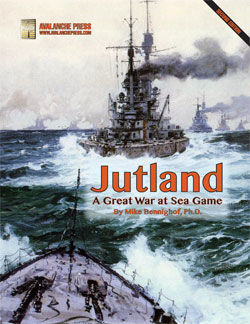 On 4 August 1914, the United Kingdom declared war on Germany. That evening, Winston Churchill, First Lord of the Admiralty, transmitted a simple message to all of the Royal Navy’s stations: “Commence hostilities against Germany.” On 4 August 1914, the United Kingdom declared war on Germany. That evening, Winston Churchill, First Lord of the Admiralty, transmitted a simple message to all of the Royal Navy’s stations: “Commence hostilities against Germany.”
Concentrated at Scapa Flow, in the Orkney Islands north of Scotland, the Grand Fleet depended on its dreadnought battleships for its striking power – the currency by which naval power was measured the world over. All of the Grand Fleet’s dreadnoughts appear in our Great War at Sea: Jutland game. Here’s a look at them:
The First
The ship that gave her name to an age, at least for naval affairs. The all-big-gun battleship Dreadnought was an evolutionary design, which did not take full advantage of the firepower of her dozen 12-inch guns (all turrets were on the same level, and most had restricted fields of fire). She marked a switch from triple-expansion engines to turbines, which would power most (but not all) of the battleships now known as “dreadnoughts,” but was only slightly larger than the previous class of pre-dreadnought battleships.
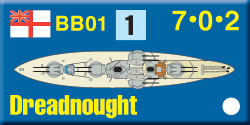 Dreadnought was built quickly to make a public relations splash, and as a result wore out quickly, too. She was not present at the Battle of Jutland; though less than ten years old her engines were already unable to maintain the fleet’s normal cruising speed. She was relegated to operating with the Third Battle Squadron in the English Channel, made up of pre-dreadnoughts for the last few years of the war, with a brief return to the Grand Fleet. Dreadnought was built quickly to make a public relations splash, and as a result wore out quickly, too. She was not present at the Battle of Jutland; though less than ten years old her engines were already unable to maintain the fleet’s normal cruising speed. She was relegated to operating with the Third Battle Squadron in the English Channel, made up of pre-dreadnoughts for the last few years of the war, with a brief return to the Grand Fleet.
The Copies
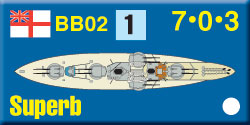 Having settled on a standard design for its new battleship, the Admiralty ordered many copies. Three new ships were built under the 1906 program, the Bellerophon class, with some improvements to their underwater protection and a tertiary battery of four-inch guns in place of the three-inch weapons in Dreadnought. Three more followed in the next fiscal year, very similar but with a longer-barreled 12-inch gun that provided greater range and hitting power (not enough of a difference to show up in their Great War at Sea ratings, though). These six copies had better construction than Dreadnought, but were just barely considered front-line units by the end of the Great War. One exploded in 1917 and two were detailed for service in the Mediterranean theater, with the others slated to follow. All of the survivors, as well as Dreadnought herself, were deleted soon after the war (before naval armaments limitation talks began). Having settled on a standard design for its new battleship, the Admiralty ordered many copies. Three new ships were built under the 1906 program, the Bellerophon class, with some improvements to their underwater protection and a tertiary battery of four-inch guns in place of the three-inch weapons in Dreadnought. Three more followed in the next fiscal year, very similar but with a longer-barreled 12-inch gun that provided greater range and hitting power (not enough of a difference to show up in their Great War at Sea ratings, though). These six copies had better construction than Dreadnought, but were just barely considered front-line units by the end of the Great War. One exploded in 1917 and two were detailed for service in the Mediterranean theater, with the others slated to follow. All of the survivors, as well as Dreadnought herself, were deleted soon after the war (before naval armaments limitation talks began).
We Want Eight
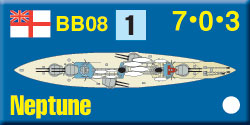 But had to settle for three. The “Naval Scare” of 1909 featured the Unionist Party slogan, “We want eight and we won’t wait,” urging that eight dreadnoughts be laid down immediately rather than the four planned by the government. Three of the ships would be an improvement on the basic Dreadnought design, with the fourth a new battle cruiser similar to the original Invincible. The agitators did eventually get their way, and thanks to the delay the Royal Navy received much more powerful ships of the Orion class (see below). But had to settle for three. The “Naval Scare” of 1909 featured the Unionist Party slogan, “We want eight and we won’t wait,” urging that eight dreadnoughts be laid down immediately rather than the four planned by the government. Three of the ships would be an improvement on the basic Dreadnought design, with the fourth a new battle cruiser similar to the original Invincible. The agitators did eventually get their way, and thanks to the delay the Royal Navy received much more powerful ships of the Orion class (see below).
Dreadnought and her near-sisters had been built quickly, and Neptune – actually built under the 1908 appropriations - represented an evolution of the basic type, the first opportunity to take some lessons from the original. She had the same number of heavy guns as Dreadnought, but two of her turrets featured the superfiring arrangement (one raised above another) pioneered by the Americans with their South Carolina while the two “wing” turrets could theoretically fire on either broadside (in practice, this proved difficult).
Two near-copies were laid down under the 1909 fiscal year program, Hercules and Colossus, that were actually less well-designed than Neptune. But the next dreadnoughts would represent a serious step forward in fighting power.
Super Dreadnoughts
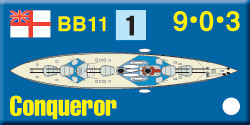 When the Germans upgraded from 11-inch main batteries to 12-inch guns, the British kept pace by switching from 12-inch to 13.5-inch. Three classes totaling a dozen ships mounted the new 13.5-inch gun in five double turrets, arranged two fore and two aft in superfiring pairs, and one sited amidships. That made for a far superior design, and along with the 12 built for the Royal Navy, four additional near-sisters were laid down for foreign customers, two for Chile and two for Turkey (see below). When the Germans upgraded from 11-inch main batteries to 12-inch guns, the British kept pace by switching from 12-inch to 13.5-inch. Three classes totaling a dozen ships mounted the new 13.5-inch gun in five double turrets, arranged two fore and two aft in superfiring pairs, and one sited amidships. That made for a far superior design, and along with the 12 built for the Royal Navy, four additional near-sisters were laid down for foreign customers, two for Chile and two for Turkey (see below).
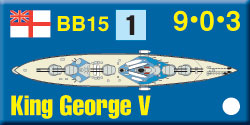 The new design was much larger than previous dreadnoughts, with much thicker armor protection. However, they retained the same inadequate underwater defenses as Neptune and the only one lost during the war, Audacious, sank after striking a single mine. All of them burned coal, and made 21 knots (a couple managed 22). The new design was much larger than previous dreadnoughts, with much thicker armor protection. However, they retained the same inadequate underwater defenses as Neptune and the only one lost during the war, Audacious, sank after striking a single mine. All of them burned coal, and made 21 knots (a couple managed 22).
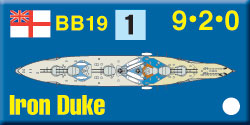 Each class made incremental improvements on its predecessor. The second group, known as the King George V class, finally moved the mast in front of the forward smokestack. The third group, the Iron Duke class, finally increased the caliber of their secondary armament from four-inch to six-inch. Each class made incremental improvements on its predecessor. The second group, known as the King George V class, finally moved the mast in front of the forward smokestack. The third group, the Iron Duke class, finally increased the caliber of their secondary armament from four-inch to six-inch.
“Fast” Battleships
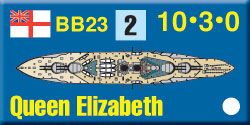 For the 1912 fiscal year, the Admiralty considered a number of designs starting with a fourth class of Iron Duke-type super-dreadnoughts armed with 13.5-inch guns. The new First Lord of the Admiralty, Winston Churchill, pressed for adoption of the 15-inch gun, citing reports that the Germans had a 13.8-inch main armament under consideration. For the 1912 fiscal year, the Admiralty considered a number of designs starting with a fourth class of Iron Duke-type super-dreadnoughts armed with 13.5-inch guns. The new First Lord of the Admiralty, Winston Churchill, pressed for adoption of the 15-inch gun, citing reports that the Germans had a 13.8-inch main armament under consideration.
Eight 15-inch guns produced a heavier broadside than ten 13.5-inch guns, and removing the central turret provided space for much more powerful machinery – the new ships generated two and a half times the horsepower generated by Iron Duke. But while designed for speed, the Queen Elizabeth class disappointed, never making more than a hair over 24 knots. Their ability to operate alongside battle cruisers was greatly overstated in the British naval press. In game terms their speed may be overrated.
Initially planned as a class of four ships, a fifth was added when the British leaned on the Federated Malay States to make a “gift” of a battleship, and a sixth (which would never be built) replaced the cancelled sister ship of the battle cruiser Tiger. The Admiralty pressured Canada to make a “gift” of three more, but the effort collapsed when the Canadians insisted that ships built with Canadian funds should be built in Canadian yards by Canadian workers. The Vickers-Armstrong conglomerate exerted its political muscle to quash the deal even though the ships would have been built by a subsidiary.
All five ships actually built survived the First World War and saw extensive service in the Second, some of them after large-scale reconstruction.
Slow Battleships
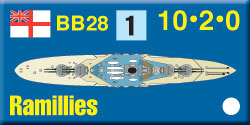 The next class of battleships reverted to the “fleet speed” of 21 knots, with the same main armament as Queen Elizabeth but a slightly smaller hull. They also reverted to a less optimal armor scheme in a cost-saving measure, yet while the Queen Elizabeths cost £2.3 million apiece; the Revenge class actually cost slightly more thanks to wartime price gouging. The next class of battleships reverted to the “fleet speed” of 21 knots, with the same main armament as Queen Elizabeth but a slightly smaller hull. They also reverted to a less optimal armor scheme in a cost-saving measure, yet while the Queen Elizabeths cost £2.3 million apiece; the Revenge class actually cost slightly more thanks to wartime price gouging.
The big difference was concern over fuel: the Queen Elizabeth class exclusively burned oil, the first British battleships to do so. Petroleum had to be imported into the United Kingdom (North Sea oil still lay 50 years in the future), whereas Britain produced abundant coal. The initial idea to fuel the Revenge class with coal, just like Iron Duke, was undermined by First Sea Lord Jackie Fisher, who used his influence to install a mixed coal and oil arrangement (fairly common in German battleships). That put the Revenge class under the same steaming restrictions as the Queen Elizabeths once the German submarine campaign severely cut British oil imports by 1917.
Five of the planned eight ships were completed, two of them in time for the battle of Jutland. None received any damage during the Great War. The armor arrangement made it difficult to replace the machinery in the Revenge class, and they were not modernized after the war to the same extent as some of the Queen Elizabeths.
The Foreigners
 Britain was a major arms exporter during the years before the Great War, and when war broke out a number of dreadnoughts were under construction in British yards. Two Turkish ships had just been completed, and First Lord of the Admiralty Winston Churchill convinced the builders to delay handing them over until they could be seized for use in the Royal Navy. Agincourt, the former Sultan Osman I, had originally been contracted by Brazil and was a true one-of-a-kind ship, boasting fourteen 12-inch guns in seven turrets. Britain was a major arms exporter during the years before the Great War, and when war broke out a number of dreadnoughts were under construction in British yards. Two Turkish ships had just been completed, and First Lord of the Admiralty Winston Churchill convinced the builders to delay handing them over until they could be seized for use in the Royal Navy. Agincourt, the former Sultan Osman I, had originally been contracted by Brazil and was a true one-of-a-kind ship, boasting fourteen 12-inch guns in seven turrets.
Erin, the former Reshadiye, was a slightly smaller version of the King George V class. A sister had been ordered at the same time. but built at a much slower pace thanks to Turkish financial weakness, and construction had been abandoned when payments were abandoned.
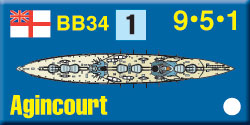 The Chilean Almirante Latorre was an enlarged version of King George V, with 14-inch guns in place of the 13.5-inch weapons of her British near-sisters. She was purchased in September 1914 and commissioned as Canada one year later. Though the purchase lacked the armed drama of the Turkish seizure, the Chileans were not given an alternative to accepting the offer. Her much less advanced sister ship was purchased in 1917 and converted into the aircraft carrier Eagle. Plans to complete her as the battleship India did not go forward; the Royal Navy already had one “odd number” in her sister. The Chilean Almirante Latorre was an enlarged version of King George V, with 14-inch guns in place of the 13.5-inch weapons of her British near-sisters. She was purchased in September 1914 and commissioned as Canada one year later. Though the purchase lacked the armed drama of the Turkish seizure, the Chileans were not given an alternative to accepting the offer. Her much less advanced sister ship was purchased in 1917 and converted into the aircraft carrier Eagle. Plans to complete her as the battleship India did not go forward; the Royal Navy already had one “odd number” in her sister.
Order Jutland second edition here.
Please allow an extra four weeks for delivery.
Sign up for our newsletter right here. Your info will never be sold or transferred; we'll just use it to update you on new games and new offers.
Mike Bennighof is president of Avalanche Press and holds a doctorate in history from Emory University. A Fulbright Scholar and NASA Journalist in Space finalist, he has published a great many books, games and articles on historical subjects; people are saying that some of them are actually good.
He lives in Birmingham, Alabama with his wife, three children, and his new puppy. His Iron Dog, Leopold, could swim very well.
Want to keep Daily Content free of third-party ads? You can send us some love (and cash) through this link right here.
|
